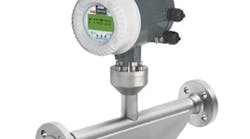In the past 10 years, Coriolis mass flowmeters have taken over the market spaces of many other flowmeter technologies. Their ability to provide mass flow, volumetric flow, density and temperature measurements on a highly accurate basis is unrivaled by other types of meters. Coriolis mass flowmeters have been replacing mechanical meters (positive displacement and turbine meters— especially in custody transfer applications) because user maintenance can be reduced up to 90% using Coriolis mass flowmeters. This, according to both ARC Advisory Group and Flow Research Inc., is one of the key reasons why the market for Coriolis mass flowmeters is growing rapidly.
ABB has been making Coriolis mass flowmeters since the early 1990s, and they've just introduced their latest design, the CoriolisMaster. This meter is very different, according to ABB, and is a state-of-the-art product.
"When we were looking at our Coriolis mass flow product line," says ABB's global product manager for Coriolis flowmeters, Frank Frenzel, "We wanted to leverage our experience and design an optimized Coriolis flowmeter with an easy-to-program interface."
Figure 1. The CoriolisMaster has one of the shortest laying lengths and pressure drops in the industry.
ABB, through its predecessor companies, is justifiably proud of its 100-year record of innovation in flow measurement and other automation products. Frenzel says the new CoriolisMaster flowmeter is no exception. "With thousands of Coriolis mass flow products in the field, we felt we had a very good grasp of what features would actually make a flowmeter better."Using complex modeling and simulation techniques, the design team optimized the sensor design for higher performance, too. Frenzel notes. "Finite element simulations and several design loops created an optimized design with superior zero-point stability and superb temperature stability," he says. "New node point designs, shorter tube lengths and stiffer housings are reasons we believe we've developed one of the best sensor designs in the industry."
Frenzel's team designed a shorter laying length meter, so the CoriolisMaster would have one of the shortest laying lengths (end-to-end or flange-to-flange dimension) in the industry—up to 40% smaller in length and meter volume. This permits the meter to be used in tighter quarters, with less re-piping than other meters from ABB or other vendors.
"We also re-designed the flow tube diameters to provide 50% to 90% lower pressure drop, one of the lowest in the industry," Frenzel says, "which gave us nearly double the maximum flow of competitive flowmeters of the same diameter."
Frenzel points out that this wide flow range per meter means end users can use a minimum number of meter sizes.
The new lower pressure drop measuring tube design also saves energy. "The end user can save pump power by up to 50% with our double tube design and one of the lowest pressure drops on the market," Frenzel says.
The new design is also equipped with a new transmitter design. "Using ABB's intuitive interface, it is capable of being programmed without a manual," Frenzel says. "The transmitter provides excellent turndown and zero point stability," he goes on, "and the signal conditioning algorithms are designed to handle tough applications."
The CoriolisMaster is being released in three line sizes, 0.5-in. (DN15), 1-in. (DN25) and 2-in. (DN50), with three more sizes to be released yet this year: 3-in. (DN80), 4-in. (DN100) and 6-in. (DN150). Tests of the new design at the Clean Energy and Environmental Sustainability Initiative (CEESI) and metrology services provider NMi Netherlands show just how highly accurate the CoriolisMaster is, and ABB claims 0.1% of rate accuracy for both flow and density.
The CoriolisMaster is available immediately in the three released line sizes.
For more information, contact ABB at www.abb.com/flow.



